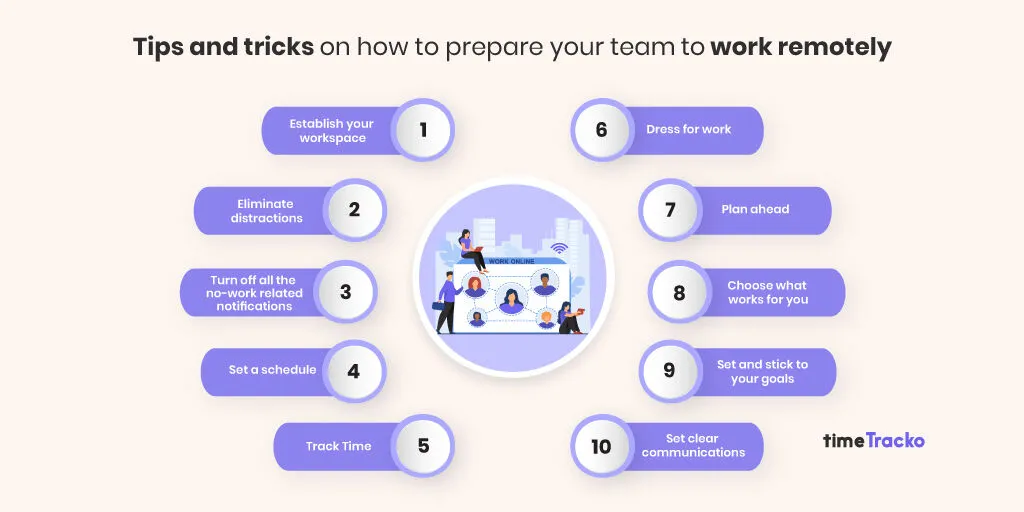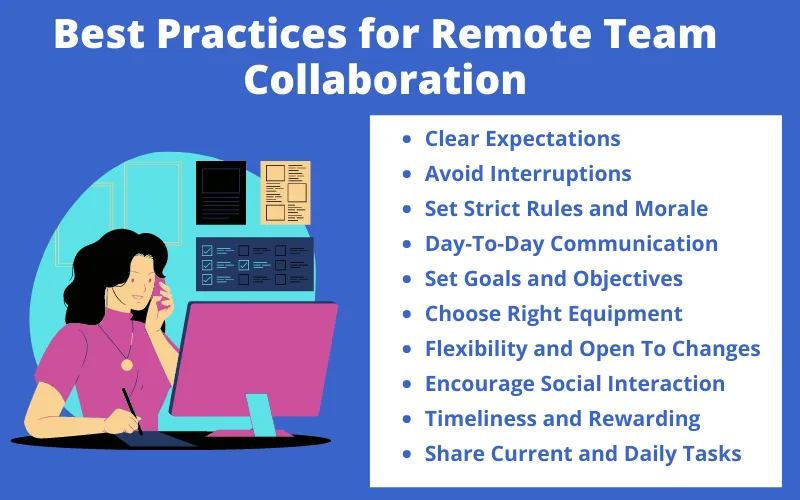10 Best Practices for Effective Remote Team Collaboration
10 Best Practices for Effective Remote Team Collaboration
Remote team collaboration is possible when officials are working from two different continents, and the members are still collaborating in a team.
The workers are far physically, but productivity is excellent with good revenue generation. This is the adoption of good practices for remote team collaboration.
When working in an office, everyone needs to work together, discuss work strategies, divide work, take feedback on work assigned, look at the degree of work completed, and move forward.
It is even more necessary to work in a team by virtual collaboration and wait for happy hours.
What is Remote Team Collaboration?
Remote team collaboration refers to collaboration among team members with physical distance as the main problem.
Office work includes various activities like communication, discussion, and everything required to run an office daily. Still, the only difference is that the remote workers are not physically present with one another.
Remote team cooperation is the potential of a team to operate strongly from any part of the world to conduct organizational duties in good cooperation with the team members.

If a team couldn’t discuss and make plans virtually, many companies would not exist.
Importance of Remote Team Collaboration
When your counterpart is far away from you, there are some good and some bad points to keep in mind.
Remote team collaboration is important as it helps in the overall functionality of the office and its people. The work is to be done efficiently and help others by managing remote teams.
Remote team collaboration leads to isolation of ideas if one of the team members is not open about the work conditions.
Here is some importance of remote working:
- Remote work helps to save travel time and time to get ready to reach work. When you work remotely, you can utilize time for office work, staying at home, and increasing productivity.
- Remote working keeps officials flexible as they can attend online meetings, and effective virtual meetings to work on themselves. The attendance level is increased as there is no time necessary for commuting.
- Working from home helps balance a person’s life as a family member and official. Remote working helps save the cost of remote workers, i.e., the one providing a job and getting a job.
- Remote work has greatly affected the hierarchical model of office operation as everyone contributes equally to work, and virtual meetings do not remind of hierarchy in a company.
- Remote working includes using productivity management and time tracking apps, making employees more productive and eager for work.
Why are Best Practices Necessary for Remote Team Collaboration?
Remote working is beneficial, but at the same time, it comes with a lot of challenges. Some challenges of remote work include a feeling of isolation among team members.
When employees are remotely working or video conferencing, some go out of notice, lose visibility, and remain unnoticed for rewards or promotion.
Remote work may also lead to an imbalance of personal and family life. For some team members, the bonding and rapport are lost.
Employees tend to lose focus and get distracted, which leads to less productivity during remote team discussions.
To avoid and get past the problems that can arise in remote work, it is best to adopt practices for remote collaboration that help in better communication and team participation and help make work-life better.
Best Practices for Remote Team Collaboration

For remote team collaboration, soft skills are a must. Soft skills help strengthen the far yet near relationship between the team members, leading to better communication, presence, and productivity.
Some best tips for effective collaboration and practices for remote collaboration are:
Clear Expectations
When working in a team, fulfilling every team member’s expectations, criteria are set up for better remote team collaboration.
Every member of the team should respect the time bondage of each member and work accordingly.
The ground rules ensure that everything is under control; work division also plays an important part in remote work.
Meeting Deadlines, discussions, and better plans clarify the roles and duties and prioritize documentation.
For instance, your lead has assigned you to work for the day. You are expected to complete the task by afternoon.
Ensure you know what type of work is expected from you and how long it will take to meet the deadline. If you are not sure, then let the lead know.
Avoid Interruptions
Many people talk for online business communication and meetings, resulting in more expression than listening.
When a team meeting occurs, it is important to maintain discipline online while communicating by having the patience to listen to others while speaking.
Avoiding interruptions includes waiting for your turn to speak after others finish their talks in a team meeting.
Effective virtual meetings are not as often as the regular colleague meetings at work and have a time limit.
For instance, you are attending virtual meetings, and someone else is talking about their work.
At that time, all team members want to express their views. Talking all at once can create chaos, so asking for permission to put out your ideas rather than interrupting is better. This strategy is for managing remote teams.
Set Strict Rules and Morale
Rules and moral values help keep employees stable and realize what is expected. Remote working policy strengthens team alliance.
When every employee follows the discipline, there are no problems that arise.
When problems arise, it is better to make the person understand and talk to them to make the required corrections.
For instance, one of the team members in remote work is not present in meetings and has not completed their task for the day. In this situation, the team should contact the member and ask for work outputs.
Day-To-Day Communication
Remote work requires daily communication and lacks face-to-face interactions and bodily gestures for feeling connected.
The team members need to interact with the help of communication channels like Zoom and Microsoft Teams. Misinterpretations and misunderstandings are common in remote interaction.
Utilizing tools like WhatsApp Business on multiple devices enables seamless communication, allowing team members to share instant updates, ask questions, and provide feedback
Daily communication is a vital part of developing organizational values and productivity. For instance, in remote team collaboration, you need to report your work and ask questions.
For this purpose, the correct tool will help employees communicate daily, increasing happy hours. But with the proper plan and tools, miscommunication is reducible.
Set Goals and Objectives
Setting goals and objectives is the foremost task necessary for developing a company. When team members cooperate remotely, certain goals with team culture should remain in mind to achieve them.
It is equally important to remind employees what the organizational goal is. For instance, your employees have to take surveys for customer feedback.
For this purpose, remind the employees of the number of emails they need to send in a day. The daily activities will help the total number of sales to rise.
Choose Right Equipment
It is through the equipment that remote team cooperation takes place. The basic requirement is the internet and devices for work.
When the office sets proper hardware and software criteria, remote team collaboration occurs fluently.
For instance, an employee operates from a place with heavy snowfall, and the internet is slow due to hailstorms.
It is better to inform the office members about its current situation. It is the responsibility of officials to understand and even provide better equipment when employees demand so.
Flexibility and Open To Changes
Rigidity is one thing to avoid while collaborating in remote teams via business communication. The main charm of remote work lies in exploring ideas and working amid difficulties.
An office is always perfect and has everything it needs, but while working remotely, you crave perfection even in the imperfection of either equipment or social interactions or resources.
So when all employees are flexible and ready to take anything that comes to office work, they can collaborate openly at work.
Openness also applies to accepting mistakes and not passing judgments while working in a team. It includes accepting others’ ideas and trying to introspect and improve further.
Encourage Social Interaction
Working away from the office means staying away from colleagues who are your friends, and it gets hard to trust the team when you work remotely.
Working from home can make people who live alone feel lonely and isolated. The separation can lead to many problems, harm overall social wellbeing, and increase absenteeism and low morale with less productivity.
It is better if social interactions are increased in remote work. For instance, employees can plan a trip together and celebrate birthdays and holidays. For virtual refreshments, online game sessions and puzzles are good options.
Timeliness and Rewarding
Punctuality is an important virtue to remember not only by employees but also by employers. Time is an important factor in remote team collaboration as remote employees may waste time.
It can be the starting day when you begin work with attendance on time. The regular meetings require every employee to report on time.
In lack of punctuality, a project remains incomplete, and communication becomes impossible while collaborating remotely. It would help if you remembered punctuality with other good manners.
It is a must to remember punctuality with other good habits. An honest, hardworking, and dedicated employee always deserves rewards.
Share Current and Daily Tasks
The idea of sharing what is happening in every employee’s life in a team gives an insight to listeners and is good for the employee.
All employees can know what the others are up to. When you share your present situation with other employees, they are always there for you.
Daily standups encourage employees to work better and with more productivity. When employees know what their colleagues are doing, healthy competition leads to better output.
In difficult situations like an emergency, team members are always ready to help. A remote team is a team for collaboration and a social team that encourages empathy.
Updating your team on the current situation leads to good friendship and emotional, moral support during tough times.
Conclusion
Remote work statistics help the company visualize how remote working is with the talent pool.
Remote collaboration leads to a collaborative visual environment among team members who work on the onboarding process of meeting organizational aims and goals.
The main aim of remote team collaboration is feeling connected via a different communication channel.

 in Melbourne
in Melbourne 
 Employee Screen Monitoring Software
Employee Screen Monitoring Software App and Website Monitoring Software
App and Website Monitoring Software Time and Attendance Software
Time and Attendance Software Finance
Finance Banking
Banking Healthcare
Healthcare Lawyers
Lawyers Retail & ecommerce
Retail & ecommerce Knowledge base
Knowledge base Blogs
Blogs Installation Guide
Installation Guide FAQs
FAQs About
About Media Kit
Media Kit Contact us
Contact us